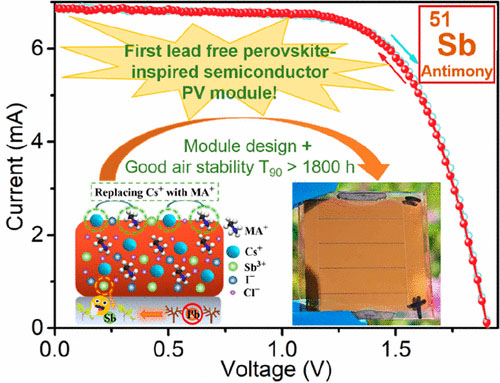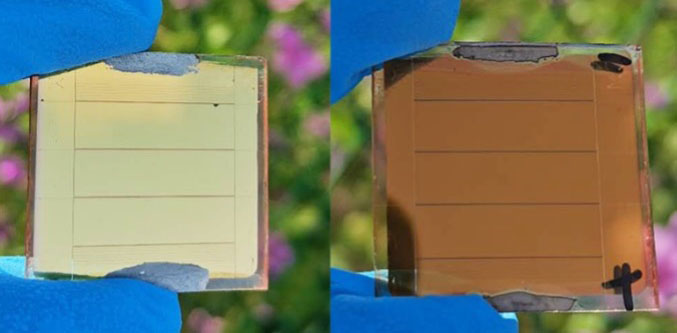| Feb 20, 2024 | |
Unveiling lead-free antimony-based perovskite solar modules |
|
| (Nanowerk Spotlight) Solar energy holds enormous untapped potential as a clean, renewable power source. But as silicon panels approach their practical efficiency limits, scientists have turned to revolutionary lead-halide perovskites as a way forward. | |
| Since their emergence roughly a decade ago, lead-halide perovskite solar cells have rapidly ascended as a revolutionary photovoltaic technology. Thanks to their superb light absorption and charge transport capabilities, perovskite solar cells now rival classic silicon, with recorded efficiencies surpassing the 26% threshold. Additionally, their simple and low-cost fabrication methods like printing and spraying present the opportunity to finally deliver solar electricity to the masses. | |
| This presents an opportunity to finally deliver on solar's long-held promise of clean, renewable energy for all. | |
| However, concerns linger regarding toxicity and recyclability issues with lead. Unstable lead exposure may pose environmental and health dangers, while limited stability caps operational lifetime for lead-perovskite devices. | |
| Most pressingly, concerns linger regarding lead’s toxicity which poses environmental and health dangers. Unstable lead exposure through gas, water, and soil accumulation could have irreversible consequences if not properly controlled and recycled as perovskite use expands globally. | |
| There are also stability issues limiting operational lifetime for lead-perovskite devices themselves. Researchers have attempted to replace lead with slightly less toxic tin, but thus far tin-based perovskites still suffer from air instability. Without breakthroughs in stability and environmental safety, scaling perovskite solar technology could flood our waste stream with hazardous materials. | |
| Now, scientists led by the Centre for Hybrid and Organic Solar Energy (CHOSE), Electronic Engineering Department at Tor Vergata University of Rome, may have found a solution in a new lead-free antimony-based perovskite solar cell design. | |
| Published in ACS Energy Letters ("Air-Stable Lead-Free Antimony-Based Perovskite Inspired Solar Cells and Modules"), the research demonstrates a mixed-cation perovskite-inspired material (PIM) that boosted efficiency by 81% compared to conventional cesium-only antimony solar cells, while also exhibiting unmatched stability. | |
 |
|
| Current density−voltage (J−V) curves for the MA1.5Cs1.5Sb2I3Cl6 module (active area: 3 × 0.84 cm2), measured under standard test conditions (AM1.5G, 1000 W/m2). Insets are schematic of antimony (Sb)-based perovskite-inspired material composition (left) and front-view photo of the fabricated module (right). (Image: Courtesy of the researchers) | |
| “Unlike unstable tin-based perovskites, the antimony PIM maintained 90% of its efficiency after 1,800 hours in ambient air conditions,” Jie Xu, the paper’s first author, tells Nanowerk. “This durability enabled us to manufacture the first-ever lead-free perovskite solar module using industry-standard laser patterning techniques – a pivotal step toward commercial viability.” | |
| Antimony is a silvery-white metalloid gaining traction as an eco-friendly perovskite alternative. Antimony boasts similar elecronic properties to lead, can bond with halides to form perovskite-like crystal structure, and potentially exhibit lower toxicity than lead, which must be analyzed from different angles (e.g., toxicity of elements and derivative compounds according to different tests, environmental footprint, life cycle analysis, which depends also on efficiency and performance etc.) | |
| Early antimony-based devices showed potential but lacked large area and stability required for commercial relevance. But by engineering a new mixed-cation methylammonium-cesium antimony triiodide chloride composition, the researchers unlocked substantial improvements on both fronts. | |
| The optimized solar cell achieved 1.53% efficiency – an 81% boost over cesium-only devices; yet still significantly lower than lead-based perovskite solar cells, which have shown rapid improvements in efficiency, reaching over 26% in laboratory settings. Far exceeding stability benchmarks, the antimony films maintained nearly full efficiency after prolonged exposure to air and humidity. | |
| According to Prof. Thomas Brown, who led this work, these findings could position antimony as the next-gen successor to toxic lead-based perovskites and unstable tin alternatives. | |
| “Whereas there is scope for improvement in efficiency, it is the stability of the cells that represents the key property of the PIM devices fabricated here,” Brown said. | |
| Bolstered by the antimony cell’s durability, Brown’s team became the first ever to fabricate a lead- and tin-free perovskite solar module using industry-standard laser patterning in air – evaporating unwanted layers to isolate individual cells connected in series. | |
| Previously, longer air exposure during patterning quickly degraded lead-free perovskite films, e.g. tin-based ones. But the antimony PIM’s resilience enabled tuning specialized laser fluency parameters with all steps performed in ambient air. | |
 |
|
| Photos of the fabricated antimony-based perovskite inspired solar module from back side (left) and front side (right). (Image: Courtesy of the researchers) | |
| The antimony minimodule achieved 1.2% efficiency over a 2.52 cm2 active area, proving the concept’s feasibility. | |
| With room for optimization, the antimony roadmap mirrors early lead-perovskite solar module development which climbed from 5% to over 20% efficiency in under a decade. More immediately, enhanced stability unlocks pathways to commercial manufacturing. | |
| “Successful fabrication with a fully laser-patterned series-integrated cell and outstanding stability reveals new potentialities for large-scale production of potentially greener photovoltaics,” explains Xu. | |
| By tackling efficiency while maintaining stability – the inverse of tin’s challenges – antimony-perovskites could close the gap with the current lead-based panels on performance too. Further research will concentrate on device physics, while also investigating true sustainability considering recyclability and life cycle analyses. | |
| For now, the team’s antimony innovation represents a promising stride toward economical solar energy free of toxic tradeoffs. If the technology continues on its current trajectory, antimony’s moment in the sun may just be dawning. | |
 By
Michael
Berger
– Michael is author of three books by the Royal Society of Chemistry:
Nano-Society: Pushing the Boundaries of Technology,
Nanotechnology: The Future is Tiny, and
Nanoengineering: The Skills and Tools Making Technology Invisible
Copyright ©
Nanowerk LLC
By
Michael
Berger
– Michael is author of three books by the Royal Society of Chemistry:
Nano-Society: Pushing the Boundaries of Technology,
Nanotechnology: The Future is Tiny, and
Nanoengineering: The Skills and Tools Making Technology Invisible
Copyright ©
Nanowerk LLC
|
|
|
Become a Spotlight guest author! Join our large and growing group of guest contributors. Have you just published a scientific paper or have other exciting developments to share with the nanotechnology community? Here is how to publish on nanowerk.com. |
|
